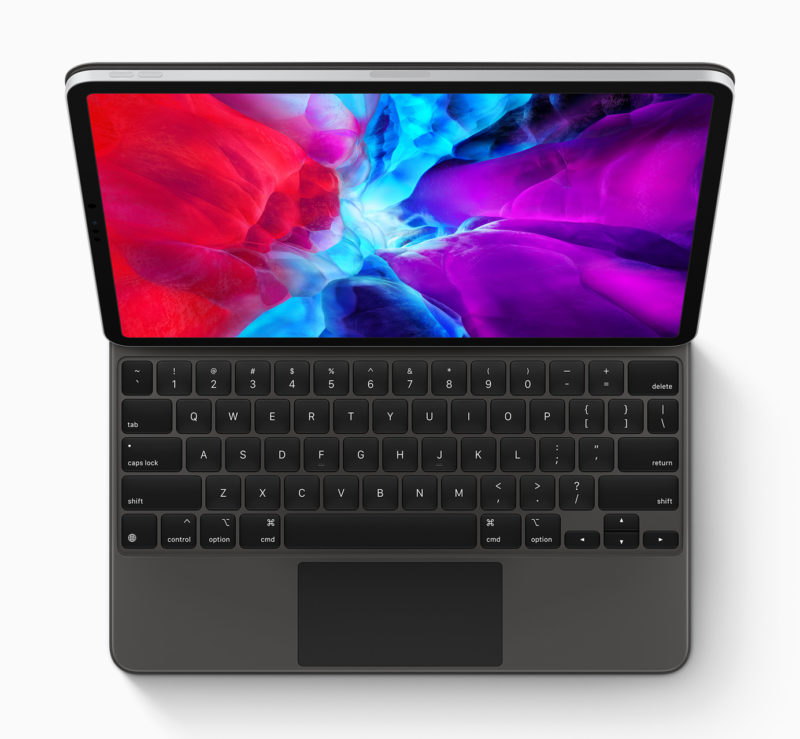On March 18th 2020 Apple gave the world another new iPad Pro. It’s been little over 500 days since the last model launched, and now we’re promised a “breakthrough LIDAR scanner” as well as trackpad support and a Magic Keyboard. As an owner of the previous 11” iPad Pro (and the keyboard that was only Smart, not Magic) I felt a familiar sinking feeling: should I have waited for this one instead? I though about my current iPad Pro; how I use it, strengths and weaknesses, what sets is apart from my laptop. Spoiler alert: the lack of “breakthrough LIDAR scanner” and Magic Keyboard didn’t come up once.

Don’t get me wrong, I love my 1 year old iPad Pro with it’s Smart Keyboard and little white pencil. I love the all-day battery life, the supreme portability, the fact that I can keep it going with the same pocketable USB charger that I use for my phone. So why do I sometimes leave it at home and bring a much bulkier laptop instead? Even my ancient 11” MacBook Air is heavier than the iPad, doesn’t run as long, and needs a bulky, proprietary power brick. The answer: because it’s less frustrating to use.
The problem with the iPad is that it’s primarily a device for consuming media, and was never intended for content creation. Nowhere is this more obvious than its keyboard, and the very helpers that made the on-screen keyboard so enjoyable to use cause no end of frustration when a physical keyboard is attached.

Fail: Unwanted Capitals
For example, when you don’t have a physical keyboard attached and position the cursor in a form field, the on-screen keyboard appears, and you can tell that the first letter will be uppercase because all of the letters on the on-screen keyboard are uppercase. I don’t know if this is truly helpful on a device large enough to facilitate easy use of the shift key, but regardless, if you don’t want to start your input with in uppercase you can just press shift once and watch the whole keyboard change to lowercase, right before your eyes. Not so with a physical keyboard. The same helpers kick in and render your first input character in uppercase, wether you wanted to or not. You press delete and try again, but still get uppercase. Briefly press shift before typing, hoping for some feature parity with the on-screen keyboard? Nope. Hold shift and start typing? Still uppercase. So you end up typing the first letter twice, and then going back to delete the spurious first capital, assuming autocorrect hasn’t kicked in and given you something completely different by now. Can you imagine putting up with this level of frustration in a laptop?
Fail: Switching Input Locale
A higher plateau of frustration is reserved for those of us who like to occasionally type in another language. Trying to do this on an iPad with external keyboard is almost impossible, despite the dedicated key for switching between different language keyboards and Emoji – a key whose use is invariably 99% accidental. Here the on-screen keyboard’s implementation is almost decent; toggle from English to German and right before your eyes you get a new keyboard layout. OK, it’s a little unfamiliar and unless you use it regularly you probably won’t be as fast as normal, but you can clobber together a sentence without too many mistakes and – crucially – with the benefit of autocorrect in your chosen language.

Repeat that process with a hardware keyboard attached, and the exact same thing happens, but with one small difference: the letters printed on your keys don’t magically rearrange themselves, and you have to start playing pot luck. After a while you learn that when you want a Z you need to hit Y, and that Ö is hidden under the semi-colon, but where the hell are the quotation marks? It’s not as if you can use the on-screen keyboard as reference because, unencumbered by physical hardware, they’ve shoehorned extra keys in here and there, something that can’t be done to the hardware keyboard without the use of hallucinogenic substances or a hammer.
Fail: Multilingual Autocorrect
You may be wondering why you’d even want to switch input locales when you’re stuck with one physical keyboard layout. The answer is simple: autocorrect on the iPad is tied to the selected keyboard, whereas on your Mac it detects the language based on your input. This means a Mac user can simply start writing in French or German and autocorrect will begin offering corrections based on French or German, whereas the iPad user has to explicitly select a language or suffer the relentless wrath of autocorrect, which remains stubbornly stuck in English. And, once you do select a language on your iPad, your fancy hardware keyboard is effectively useless.
Fail: No access to Accented Charaters
Even that most basic nod to other languages is missing from the iPad; the ability to choose an accent or umlaut by pressing and holding a hardware key. Why is that so hard to implement with your fancy iPad keyboard, Apple? Did the person who coded the on-screen keyboard leave?
Honestly, I don’t need a light-up Magic Keyboard, or trackpad support, I just need the simplest of things: intuitive input and cross-device feature parity.
What happened to it just works?